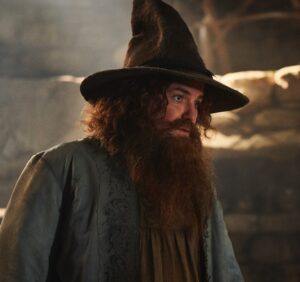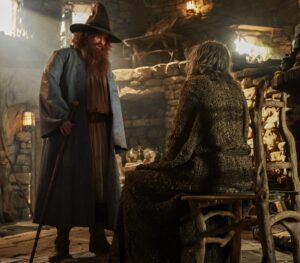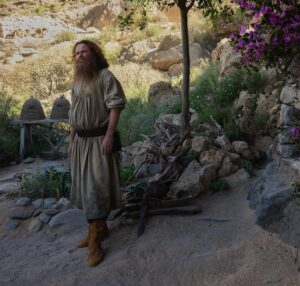I’m aware of how ridiculous this will sound, but J.R.R. Tolkien actually showed remarkable restraint as an author and worldbuilder. Yes, he seeded historical detail and mythology throughout his writings, and squeezed as much of it as possible into the Appendices to The Return Of The King, but as anyone who’s ever gone looking there for more info about the Entwives, or the Blue Wizards, or the cats of Queen Berúthiel can tell you, it’s still a pretty bare-bones summary of Middle-earth’s fictional history. The published Silmarillion and Unfinished Tales are a bit more useful, but sometimes, Tolkien would write something down and simply refuse to elaborate any further. And there’s no better example of this anywhere in his work than the character of Tom Bombadil.

Most people, if they’re familiar with Tom Bombadil at all, will know him as the capering curiosity who strays into the central narrative of The Lord Of The Rings, rescuing Frodo Baggins and his friends from a sentient and decidedly malevolent willow-tree in the Old Forest, entertaining them for a few nights at his home deep in the Withywindle river-valley before sending them on their way without even so much as a magical gift of no readily apparent purpose or a piece of advice that will prove particularly helpful in the future, the sorts of things that heroes typically earn from seemingly trivial side-quests. Nope, nothing of the sort. Technically, Tom comes back in the very next chapter and saves their lives again, this time from Barrow-wights, and he does tell the hobbits to help themselves to the wight’s treasures, including the swords that Merry, Pippin and Sam use throughout the rest of the book, so that’s something, but it’s not a gift from Tom, per se.
And with that, he’s gone (for real), and the hobbits very soon find themselves surrounded by dangers that push all memory of Tom Bombadil to the back of their – and our – minds, like an odd but not unpleasant dream. Most authors, upon realizing that they had accidentally written three straight chapters of what might arguably be called “filler”, would have either cut this section entirely or retroactively amended it to have some plot-significance, but J.R.R. Tolkien, thankfully, was not most authors. He left Tom in, and later justified his decision in a letter to Naomi Mitchison:
“Tom Bombadil is not an important person – to the narrative. I suppose he has some importance as a ‘comment’. I mean, I do not really write like that: he is just an invention (who first appeared in the Oxford Magazine about 1933), and he represents something that I feel important, though I would not be prepared to analyze the feeling precisely. I would not, however, have left him in, if he did not have some kind of function.”
— The Letters Of J.R.R. Tolkien, #144
As Tolkien makes clear, Tom actually originated in a poem published two decades prior to The Lord Of The Rings: The Fellowship Of The Ring, and later republished in a 1962 collection of Tolkien’s poetry titled The Adventures Of Tom Bombadil (a slight misnomer, as only two of the sixteen poems feature him). The original poem follows Tom as he prances unconcernedly around the Old Forest in his iconic bright blue jacket and yellow boots, racking up a rogue’s gallery to rival Batman’s, including creatures such as Old Man Willow, the Barrow-wights, and Goldberry, who becomes Tom’s wife by the end of the poem. At this point, Middle-earth already existed in Tolkien’s mind, and had begun spilling over into the settings of his poetry and short stories, but he had not yet expanded the scope of his invented world’s history beyond the bleak First Age, in which a character as whimsical as Tom would have felt utterly out-of-place. It wasn’t until several years later, while writing The Lord Of The Rings, that Tolkien would finally yank Tom out of the nebulous space where he had existed and into the Middle-earth mythos – the book, conceived as a sequel to The Hobbit written in the same whimsical style, was getting out of Tolkien’s hands, becoming larger, darker, and more complex by the moment, and Tom Bombadil might have seemed like the perfect character to help get the story back on track.
It’s interesting to think about, the possibility that Tom feels like such an interloper in the story because he represents Tolkien’s last desperate attempt at “righting course” before he gave in and let the book lead him in a different direction entirely. When Tom conveniently shows up in the nick of time to save the hobbits from murderous willow-trees and the vengeful undead, a trick straight out of Gandalf’s playbook in The Hobbit, maybe it’s not so much for their sake as it is for Tolkien’s – but that’s just my speculation. Regardless of whether Tom responded to a subconscious cry for help from the author or not, once he arrived, he became as intrinsic a part of Middle-earth as characters that had lived there much longer, and even more so than most.
It’s not for no reason that fans have long speculated as to whether Tom and his wife Goldberry are the gods Aulë and Yavanna made flesh, or if Tom is Middle-earth’s maker, Eru Ilúvatar, Himself (a theory Tolkien rebuked, for what it’s worth). At the very least, Tom is older than anyone or anything else in the world. In his own words, “Tom was here before the river and the trees; Tom remembers the first raindrop and the first acorn. He made paths before the Big People, and saw the little People arriving. He was here before the King and the graves and the Barrow-wights. When the Elves passed westward, Tom was here already, before the seas were bent. He knew the dark under the stars when it was fearless – before the Dark Lord came from Outside.” Look past the use of third-person pronouns for a moment, and focus on the phrasing and ominous capitalization that seems to suggest Tom is not from “Outside”, i.e. the universe or Eä, where all the gods including Melkor (the Dark Lord of whom Tom speaks) were gathered before they descended to earth. Of course, if that were the case, it would mean Tom Bombadil was already on earth from the very very beginning, and we can’t even begin to comprehend what that makes him. The only other lifeforms of a possibly comparable age to Tom are the “nameless things” gnawing at the roots of the Misty Mountains, which are said to be older than Sauron; himself a lesser god. Maybe some questions are better left unanswered…

While we’ll never know for sure what Tom Bombadil is, I for one have made peace with that, because I’m frankly more interested in the function he serves, as Tolkien put it. He is more than merely “the spirit of the (vanishing) Oxford and Berkshire countryside”, though that description may have been sufficient when used in 1937 by Tolkien, before The Lord Of The Rings had even begun to take shape. Allow me to share with you another illuminating excerpt from his letter to Naomi Mitchison:
“The story is cast in terms of a good side, and a bad side….moderated freedom with consent against compulsion that has long lost any object save mere power, and so on; but both sides in some degree, conservative or destructive, want a measure of control. But if you have, as it were, taken ‘a vow of poverty’, renounced control, and take your delight in things for themselves without reference to yourself, watching, observing, and to some extent knowing, then the question of the rights and wrongs of power and control might become utterly meaningless to you, and the means of power quite valueless. It is a natural pacifist view, which always arises in the mind when there is a war.”
— The Letters Of J.R.R. Tolkien #144
It’s for this exact reason that the Council of Elrond decides against giving the One Ring to Tom when the matter is discussed. Ironically, it would have too little effect on him! He would never use it, but neither would he remember to hold onto it, and after a while he might throw it away or misplace it, and give it no further thought until Sauron was on his doorstep. Would that be selfishness on his part, or on the part of those who gave him the Ring? It is not within Tom’s abilities to destroy the Ring, anyway, so this course of action would only stall Sauron for a short time, during which he would muster more force with which to crush the Free Peoples.
Tom’s neutrality, so to speak, is as much a factor in the decision by multiple filmmakers to leave him out of adaptations of The Lord Of The Rings as his insignificance to the plot or his garish wardrobe and tendency to break into song in the middle of a sentence. Especially in Peter Jackson’s film trilogy, where even the Elves are villainized for not doing enough to help humans and have to be “redeemed” by sending an army to the Battle of Helm’s Deep, or by Elrond hand-delivering Andúril to Aragorn in Dunharrow, it’s hard to imagine Tom Bombadil being let off the hook. I can all too easily envision a scenario where a staunchly isolationist Tom Bombadil has to be coerced into fighting Sauron somehow, or leading the Ents into battle against Saruman.
But I don’t yet know enough about how Patrick McKay and J.D. Payne operate to predict how they’ll utilize Tom in the fast-approaching second season of Amazon’s The Rings Of Power, which will become the first major film or TV adaptation to feature the character (a bizarre 1993 Finnish miniseries titled Hobitit technically has the distinction of being the first). Tom, played by Rory Kinnear of Black Mirror, will be one of the first characters that Elanor “Nori” Brandyfoot and the Stranger will encounter in the lands of Rhûn, which stretch beyond the easternmost boundaries of Tolkien’s map of Middle-earth, encompassing an inland sea. Tom has come to Rhûn, the showrunners revealed in an interview with Vanity Fair, to see for himself what effects the power of Sauron seeping from Mordor is having on the plants and animals there. He’s built a house in the wasteland surrounded by cacti and lemon trees, with star-charts etched on the ceilings. He’s been waiting for the Stranger, who “he knows will eventually protect the larger natural world that he cares about.”
How large a role Tom plays in the story will, I think, decide how I ultimately end up feeling about his inclusion – if he shows up out of nowhere to save Nori and the Stranger from a carnivorous cactus, gives them directions, maybe teaches them both the same song that Frodo uses three-thousand years later in the barrow to summon Tom back to his side, and rescues them once more at most before vanishing, preferably never to be seen again on the show, that could work. But if at any point he starts to move the Stranger’s subplot along a little too forcefully, or if he takes any interest in the plot at all, I’m afraid of “contrivance” becoming an issue. Tom is an anti-contrivance, if you will, his house standing not at a figurative crossroads but somewhere on a scenic detour.

As for his look, I have very little to say on the subject. His clothes are maybe a tad shabbier than I imagined, and he’s standing still in the first-look images, which I think is jarring because Tom Bombadil is so often described and depicted in artwork as “hopping and dancing”, “leaping up in the air”, “clattering in the kitchen”, “waving his arms as if he was warding off the rain”, or “charging through grass and rushes like a cow going down to drink”, but he’s instantly recognizable regardless, and I’m very excited to hear Kinnear speaking and singing in the Cornish accent he says he and dialect coach Leith McPherson settled on for the character. Oddly, there’s no sign of Goldberry anywhere. Maybe the showrunners want her to be a surprise, or maybe she’s elsewhere in Middle-earth, or not even Tom’s wife yet, but it’s a curious omission.
But I’ve rambled long enough. What are your feelings on Tom Bombadil? Share your own thoughts, theories, and opinions, in the comments below!